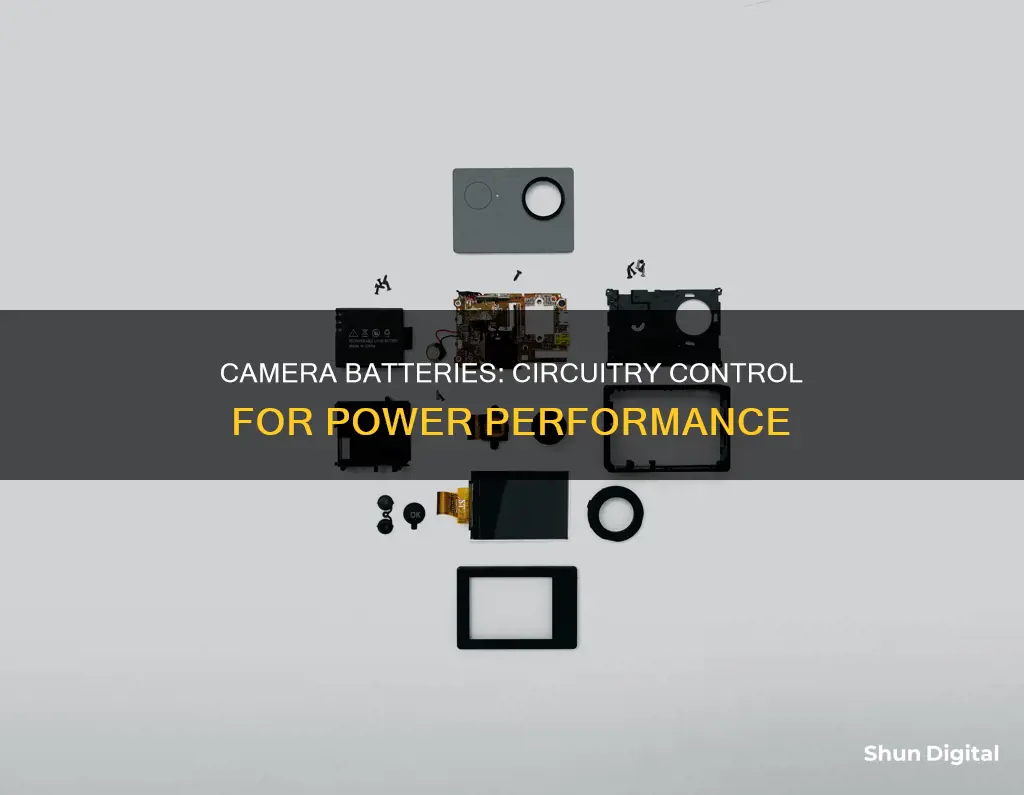
Camera batteries typically include control circuitry to ensure safety and efficiency. This circuitry is responsible for managing the charging and discharging of the battery, protecting it from overcharging and over-discharging, and preventing short circuits. It also monitors the battery's voltage and temperature, adjusting the charging or discharging process to prevent damage. Additionally, the control circuitry facilitates communication between the battery and the camera, providing information about the battery's status, such as remaining charge and estimated runtime. While most camera batteries have built-in control circuitry, there may be exceptions, such as older or lower-end cameras that use simpler batteries.
| Characteristics | Values |
|---|---|
| Do camera batteries have control circuitry? | Yes |
| What is the purpose of control circuitry in camera batteries? | To regulate the charging and discharging of the battery, monitor the battery's voltage and temperature, and provide protection against overcharging, over-discharging, and short circuits. |
| How does control circuitry help manage the charging process? | It prevents overcharging and undercharging, which can damage the battery and reduce its lifespan. |
| How does control circuitry help with temperature regulation? | It monitors the battery's temperature and adjusts the charging or discharging process to prevent damage to the battery or camera due to extreme temperatures. |
| How does control circuitry enable communication between the battery and camera? | It allows the camera to display the remaining battery charge accurately and provides warnings when the battery is low. Advanced camera batteries may also communicate detailed information about battery health and usage history. |
| Are there any exceptions to camera batteries having control circuitry? | Older or lower-end cameras may use simpler batteries without built-in control circuitry. |
| What is the role of control circuitry in camera batteries? | It ensures optimal performance and safety by managing the battery's charging, discharging, and overall performance. |
| How does control circuitry protect the battery? | It provides protection against short circuits, overcurrent, and overheating. It detects abnormal conditions and can automatically shut off the battery to prevent damage or safety hazards. |
| How has control circuitry evolved in recent years? | Advancements in battery technology have led to the development of more sophisticated control circuitry, including smart features that enhance power management and provide detailed battery information. |
| Why is control circuitry important for camera battery safety? | Control circuitry helps ensure the safe operation of the battery by managing the charging and discharging processes and protecting against potential hazards. |
| How does control circuitry contribute to voltage regulation? | Control circuitry helps maintain a stable power supply by regulating the voltage output within the acceptable range for the camera's operation. |
| What are the protection features provided by control circuitry? | Overcharge protection, over-discharge protection, and short-circuit protection. |
| How do advancements in battery technology impact control circuitry? | The development of smart batteries incorporates more sophisticated control circuitry, enabling detailed communication about battery status, such as remaining charge, estimated runtime, and battery health. |
What You'll Learn
- Camera batteries have control circuitry to ensure safety and optimal performance
- Control circuitry regulates the charging and discharging of the battery
- It also monitors the battery's voltage, temperature, and provides protection against short circuits
- The circuitry allows the camera to display the remaining charge and provides warnings when the battery is low
- Advancements in battery technology have led to the development of more sophisticated control circuitry, including smart features

Camera batteries have control circuitry to ensure safety and optimal performance
Camera batteries typically include control circuitry to ensure safety and optimal performance. This circuitry plays a crucial role in managing the charging and discharging of the battery, as well as protecting it from overcharging, over-discharging, and short circuits. It also helps to ensure that the battery operates within safe limits and maximises its lifespan.
The control circuitry in camera batteries helps regulate the charging process, preventing overcharging and over-discharging of the battery. This, in turn, helps to extend the overall lifespan of the battery and ensures it remains in optimal condition for longer periods of time. Additionally, the circuitry monitors the temperature of the battery and can adjust the charging or discharging process to prevent damage to the battery or the camera itself in extreme weather conditions.
Furthermore, the control circuitry in camera batteries provides a means of communication between the battery and the camera. It allows the camera to accurately display the battery's remaining charge and provides warnings when the battery is running low. Some advanced camera batteries even have smart features that communicate detailed information about battery health and usage history.
In recent years, advancements in battery technology have led to the development of more sophisticated control circuitry. For example, some camera batteries now feature smart circuitry that communicates with the camera, providing detailed information such as remaining charge, estimated runtime, and battery health. This allows photographers to have better control and monitoring of their battery usage, ensuring they have enough power for their photography needs.
Overall, the control circuitry in camera batteries is essential for ensuring the safe and efficient operation of the battery, protecting it from potential damage, optimising its charging process, and providing valuable information to the user.
How to Keep Your WiFi Camera Charged and Ready
You may want to see also

Control circuitry regulates the charging and discharging of the battery
Control circuitry is an essential component of camera batteries, playing a crucial role in regulating the charging and discharging processes to ensure optimal performance and safety. This circuitry acts as a "brain" for the battery, making sure it operates efficiently and within safe limits.
One of its primary functions is to regulate the charging process, preventing overcharging and undercharging. By monitoring the battery's voltage and current levels, the control circuitry ensures that the battery is charged safely and correctly, extending its lifespan and maintaining optimal condition. This is particularly important for lithium-ion batteries commonly used in cameras, as improper charging can lead to reduced capacity and safety risks.
Additionally, the control circuitry provides protection against potential hazards. It constantly monitors the battery's temperature, adjusting the charging or discharging process to prevent overheating or damage. This is especially crucial in extreme weather conditions where temperature fluctuations can occur. The circuitry also safeguards against short circuits, overcurrent, and other abnormal conditions, automatically shutting off the battery to prevent damage.
Moreover, the control circuitry enables communication between the battery and the camera. It provides information about the battery's status, such as the remaining charge and estimated runtime, allowing photographers to effectively plan their shooting schedules. Some advanced camera batteries even have smart features that offer detailed insights into battery health and usage history.
In recent years, advancements in battery technology have led to the development of more sophisticated control circuitry. These innovations aim to enhance the overall performance and safety of camera batteries, making them more reliable and user-friendly.
Charging Camera Batteries: Enercell's Quick Guide
You may want to see also

It also monitors the battery's voltage, temperature, and provides protection against short circuits
Camera batteries typically have built-in control circuitry that helps regulate the charging and discharging of the battery. This circuitry also plays a crucial role in monitoring the battery's voltage and temperature, ensuring it operates within safe limits.
One of the key functions of the control circuitry is to protect the battery from short circuits. A short circuit occurs when there is an abnormally low-resistance connection between two nodes of an electrical circuit that are intended to be at different voltages. This can lead to a sudden surge in current, potentially damaging the battery and the device it powers.
The control circuitry in camera batteries detects and prevents short circuits by monitoring the voltage and current output of the battery. If it senses an abnormal condition, it can automatically shut off the battery to prevent damage or safety hazards. This protective feature is essential for the safe and efficient operation of the battery and the camera.
Additionally, the control circuitry helps to optimise the charging process. It regulates the charging current and voltage to ensure the battery is charged efficiently and safely. By monitoring the battery's temperature, the circuitry can also adjust the charging process to prevent overheating or overcooling, which could damage the battery or the camera.
In summary, the control circuitry in camera batteries not only monitors the battery's voltage and temperature but also provides critical protection against short circuits. This ensures the safe and efficient operation of the battery, maximises its lifespan, and helps prevent potential hazards.
Charging Your Coolpix Camera: A Step-by-Step Guide
You may want to see also

The circuitry allows the camera to display the remaining charge and provides warnings when the battery is low
Camera batteries typically have control circuitry that helps regulate the charging and discharging of the battery, monitors the battery's voltage and temperature, and provides protection against overcharging, over-discharging, and short circuits. This circuitry also allows the camera to communicate with the battery and display information such as the remaining charge and estimated runtime. This feature is particularly useful for photographers as it helps them plan their shoots accordingly.
The circuitry in camera batteries serves as a means of communication between the battery and the camera. It enables the camera to accurately display the remaining battery charge and provides warnings when the battery is low. This helps photographers ensure they have enough power to capture their desired shots. Some advanced camera batteries even have smart features that provide detailed information about battery health and usage history.
The control circuitry plays a crucial role in managing the power supply to the camera, ensuring optimal performance, and enhancing overall battery life. It helps prevent overcharging and over-discharging, which can damage the battery and reduce its lifespan. Additionally, the circuitry monitors the temperature of the battery to prevent damage to the camera or the battery itself in extreme weather conditions.
In recent years, advancements in battery technology have led to the development of more sophisticated control circuitry. Camera batteries now often feature smart circuitry, enhancing power management and providing detailed battery information. This technology is constantly evolving, and we can expect further improvements in the future.
Charging Camera Batteries: Universal Charger Usage
You may want to see also

Advancements in battery technology have led to the development of more sophisticated control circuitry, including smart features
Advancements in battery technology have paved the way for a greener future, with longer-lasting, safer, and more efficient batteries. This progress has been particularly evident in the development of more sophisticated control circuitry, including smart features.
Control circuitry is an essential component of camera batteries, ensuring optimal performance and safety. It plays a crucial role in regulating the charging and discharging processes, protecting against potential hazards, and enhancing overall battery life and performance.
The circuitry helps regulate the charging and discharging of the battery, preventing overcharging and over-discharging. This regulation extends the battery's lifespan and maintains its optimal condition. Additionally, the circuitry monitors the battery's temperature, making adjustments to prevent damage to the battery or camera, especially in extreme weather conditions.
Recent advancements in battery technology have led to the development of more sophisticated control circuitry, including smart features. These advancements have allowed for more precise power management and better control and monitoring of battery usage. Some camera batteries now feature smart circuitry that communicates with the camera, providing detailed information about battery life, health, and usage history. This two-way communication allows photographers to make informed decisions about their battery usage and ensures they have sufficient power for their photography needs.
For instance, the inclusion of microchips in some camera batteries enables them to communicate essential information to the user, such as the remaining battery capacity, estimated runtime, and battery health. This information can be displayed on the camera's screen, empowering users with knowledge to plan their photography sessions effectively.
Moreover, advancements in battery technology have led to the creation of new battery chemistries, such as solid-state batteries and lithium-sulfur batteries, which offer higher energy density and increased safety. These innovations address the limitations of traditional lithium-ion batteries, such as their propensity for thermal runaway and limited lithium resources.
In conclusion, advancements in battery technology, particularly the development of more sophisticated control circuitry, have had a significant impact on the performance and functionality of camera batteries. These innovations have improved battery life, safety, and user experience, while also paving the way for a more sustainable future.
Charging Camera Batteries: How Long is Too Long?
You may want to see also
Frequently asked questions
Yes, camera batteries typically have control circuitry. This circuitry helps regulate the charging and discharging of the battery, monitors the battery's voltage and temperature, and provides protection against overcharging, over-discharging, and short circuits.
The control circuitry in camera batteries plays a crucial role in managing the power supply to the camera and ensuring the battery operates efficiently and safely. It also communicates with the camera to provide information about the battery's status, such as the remaining charge and estimated runtime.
Yes, modifying camera batteries can be dangerous and has the potential to cause damage to the camera or injury to the user. It is important to have a good understanding of electronics and battery chemistry before attempting any modifications.







